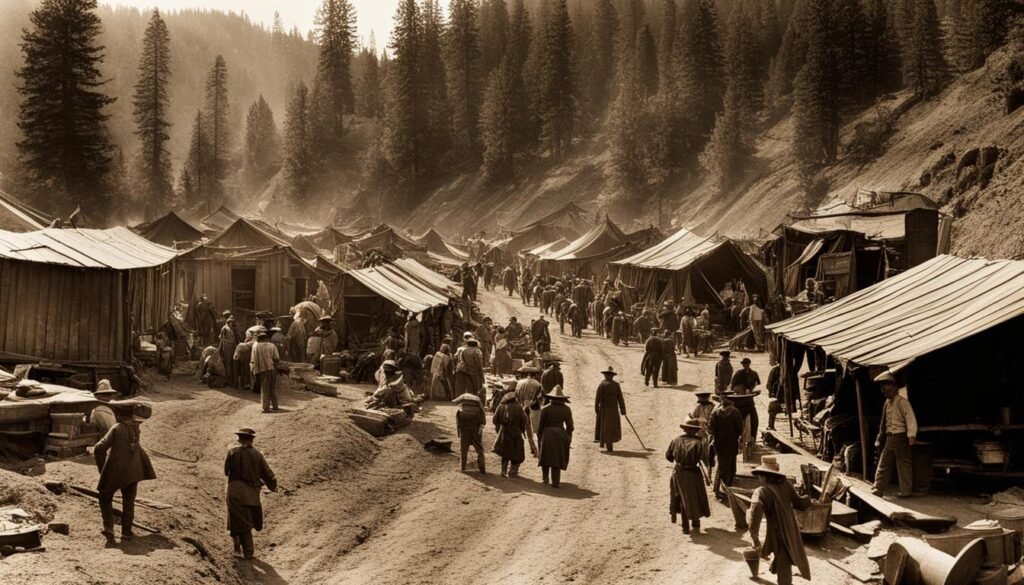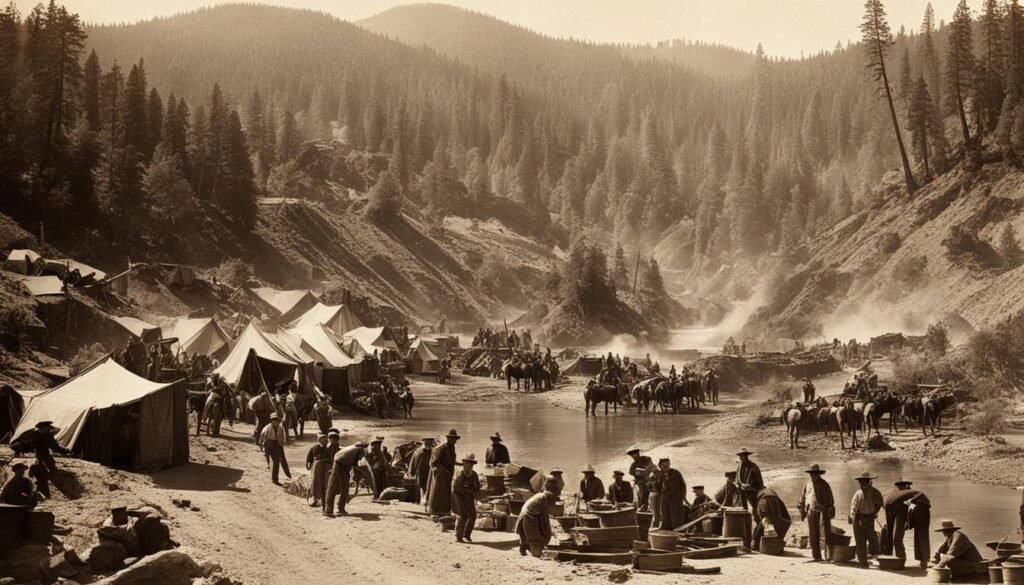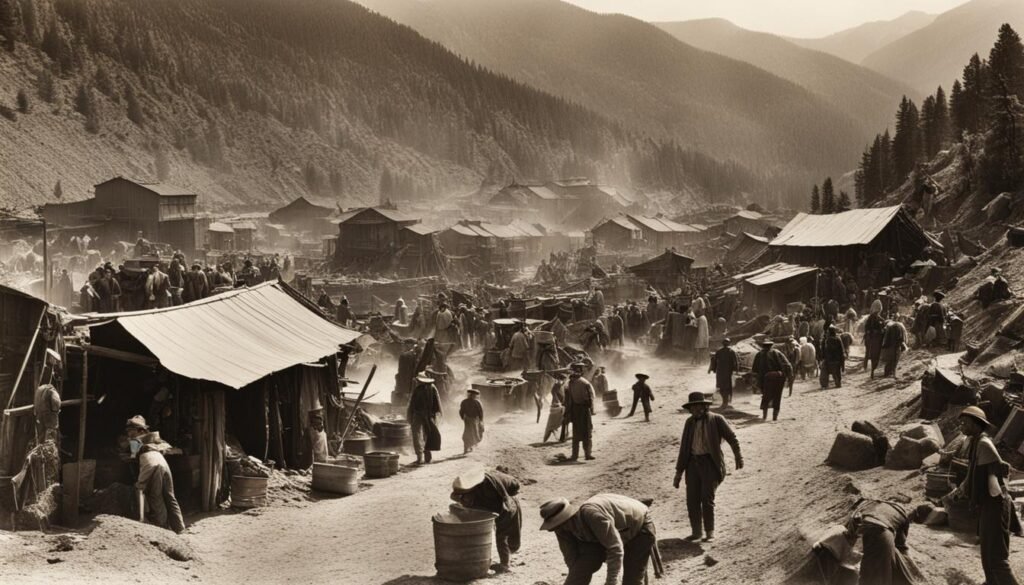Hi there, I’m excited to delve into the exhilarating history of the California Gold Rush. Join me on this adventure as we uncover the epic tales and far-reaching impact of this extraordinary event that shaped the Golden State.
The California Gold Rush, which occurred in the mid-19th century, stands as a testament to human determination and the allure of striking it rich. It all began on January 24, 1848, when James W. Marshall made a historic discovery at Sutter’s Mill in Coloma, California. Little did he know that this serendipitous moment would set off a frenzied stampede of fortune seekers.
News of Marshall’s gold find spread like wildfire, captivating the imaginations of people far and wide. From Oregon to the Sandwich Islands, and even as far as Latin America, eager prospectors flocked to the Golden State in search of their fortunes. This mass migration, referred to as the “forty-niners,” comprised around 300,000 individuals who brought their dreams, hopes, and ambitions to the untamed wilderness of California.
The California Gold Rush accelerated the development of the state and played a pivotal role in its admission into the United States. The rapid influx of people pushed California’s population to new heights, prompting the establishment of towns, infrastructure, and institutions needed to accommodate this surge.
Gold Rush California Takeaways:
- The California Gold Rush was the largest mass migration in American history, attracting around 300,000 people to California.
- James W. Marshall’s discovery at Sutter’s Mill in Coloma ignited the Gold Rush, captivating hopeful fortune seekers worldwide.
- The Gold Rush significantly impacted California’s development, leading to the accelerated admission of the state into the United States.
- The Gold Rush brought about rapid population growth, necessitating the creation of towns, infrastructure, and institutions.
- Join me in exploring the tales and impact of the California Gold Rush, a transformative era in American history.
Environmental Realities of the Gold Rush
The Gold Rush in California had significant environmental consequences. The process of mining gold, particularly through hydraulic mining, caused immense damage to the land. Forests in the Sierras and oak and redwood forests near San Francisco were decimated. Wetlands and meadows in the Sacramento and San Joaquin Valleys, once home to diverse wildlife, became barren wastelands. The mining activities also resulted in the release of toxic substances like mercury, zinc, and copper, which continue to impact California’s ecosystems today.


The Discovery of Gold in California
The California Gold Rush of 1849 was ignited by the momentous discovery made by James W. Marshall. As Marshall was constructing a sawmill at Sutter’s Mill in Coloma, he stumbled upon glimmering gold-colored specks. This chance encounter would spark a frenzy that forever shaped California’s history and economic landscape.
News of the gold discovery spread like wildfire, attracting droves of fortune seekers from all walks of life. The allure of striking it rich enticed people from far and wide, leading to a massive influx of hopeful prospectors into the region. Initially, gold was plentiful and easily found on the ground, but as the rush escalated, more advanced mining techniques were employed to extract the precious metal.
The Gold Rush reached its zenith in 1852, with thousands of eager individuals converging on the gold fields. However, by this time, the easily accessible gold deposits were depleting rapidly. Despite the declining prospect of striking it rich, the Gold Rush had already left an indelible mark on California’s history and set the stage for its future development.


Stay tuned to explore the far-reaching effects and enduring legacy of the California Gold Rush.
The Impact of the Gold Rush on California’s Population
The California Gold Rush had a profound effect on the state’s population during the mid-19th century. Approximately 300,000 people migrated to California in search of gold, resulting in a diverse and rapidly growing population.
These individuals, known as gold miners or pioneers, came from various backgrounds and countries, all drawn by the possibility of striking it rich in the gold fields. People from Europe, China, Latin America, and other parts of the United States flocked to California, creating a melting pot of cultures and traditions.
The population boom that accompanied the Gold Rush necessitated the rapid development of towns, infrastructure, and institutions. New settlements sprung up, providing living spaces, services, and supplies to support the burgeoning population.


As the population grew, the need for essential facilities such as schools, churches, and hospitals became apparent. Education was prioritized, and schools were established to cater to the needs of the growing number of children in California.
The influx of people during the Gold Rush laid the foundation for the development and transformation of California into the thriving state it is today. The pioneering spirit and perseverance of those who chased their dreams in the gold fields continue to inspire and shape the history of California.
Socioeconomic Consequences of the Gold Rush
The California Gold Rush had a profound impact on the socioeconomic landscape of the state. The discovery of gold sparked a wave of migration, stimulating rapid economic growth and transformation. As the news of gold spread, people from all over the world flocked to California in pursuit of fortune.
The influx of people created a demand for goods and services, promoting development in various industries beyond mining. Entrepreneurs seized the opportunity to cater to the needs of the gold miners, establishing businesses such as general stores, saloons, and hotels to accommodate the growing population.
The Gold Rush also fueled the expansion of transportation networks, as roads and stagecoach routes were built to connect the gold fields with other parts of California. The need for faster and more efficient transportation led to the establishment of steamship and railroad lines, further facilitating trade and migration.
Moreover, the Gold Rush played a crucial role in the establishment of banking and financial institutions in California. As gold flowed into the region, banks were established to provide financial services, such as lending, currency exchange, and securing deposits. These institutions became vital for supporting the economic activities associated with the Gold Rush.
However, it is important to note that not everyone who came to California in search of gold found success. The majority of gold miners did not strike it rich and faced significant challenges. Many struggled with poverty, disappointment, and the harsh realities of life in the gold fields.
Despite the disparities in wealth and success, the California Gold Rush had far-reaching effects on the state’s economy and development. It served as a catalyst for growth, innovation, and the rise of new industries beyond mining, shaping California into the thriving and diverse state it is today.


Cultural Diversity and Conflicts in the Gold Fields
The Gold Rush in California brought together gold rush pioneers from diverse backgrounds and cultures. Miners from different countries and regions, including Latin America, China, Europe, and the United States, lived and worked side by side in the gold fields. This cultural melting pot resulted in a fascinating mix of traditions, languages, and customs.
The California Gold Rush timeline marked an era of both opportunity and conflict. While the cultural diversity fostered a sense of unity and exchange, it also gave rise to tensions and discrimination. Native Americans and Chinese immigrants, in particular, faced significant challenges and injustices during this time.
In the chaotic scramble for gold, conflicts often arose between miners from different backgrounds. Racial discrimination and violence were sadly prevalent, as competition intensified. The gold rush in California in 1849 brought a multitude of people together, but it also exposed the darker aspects of human nature.
Despite these conflicts, the California Gold Rush effects on cultural diversity cannot be overstated. It remains a crucial chapter in both American and Californian history, shaping the state’s identity and leaving a profound impact on future generations.
Legacy of the Gold Rush
The California Gold Rush left a lasting legacy on the state and the nation as a whole. It played a crucial role in shaping the future of California, from its rapid development and urbanization to its economic and political landscape. The mining techniques and technologies developed during the Gold Rush influenced mining practices worldwide. The stories and myths surrounding the Gold Rush also became an integral part of California’s cultural identity, immortalizing the era in literature, art, and popular culture.
Pioneering Struggles and Triumphs
The gold rush pioneers, driven by dreams of wealth and adventure, faced numerous challenges on their journey to California. They braved treacherous terrains, harsh living conditions, and uncertain futures. Despite these hardships, many individuals found success and riches, forever changing their lives and the trajectory of California.
A Global Impact
The discovery of gold in California sparked a wave of migration, drawing people from all over the world to seek their fortune. This international influx of individuals from diverse backgrounds and cultures created a melting pot of ideas, languages, and traditions. Their contributions and experiences shaped the rich tapestry of California’s multicultural society.
Influences on the Global Mining Industry
The techniques and technologies developed during the Gold Rush revolutionized the mining industry. Methods such as hydraulic mining and deep shaft mining paved the way for more efficient and productive mining practices. These advancements not only impacted California’s mining operations but also had a profound influence on mining practices worldwide.
Cultural Identity and Impact on Arts
The gold rush era became deeply embedded in California’s cultural identity. The stories and adventures of the gold rush pioneers captured the imagination of people around the world. They became the subjects of countless novels, paintings, and songs, immortalizing their experiences and transforming them into legends. These artistic representations continue to shape our understanding of the Gold Rush and its impact on California’s history.
Environmental Consequences and Conservation Efforts
The California Gold Rush had significant environmental consequences that continue to impact the state today. The pursuit of gold resulted in the destruction of forests, wetlands, and native habitats, leading to long-lasting effects on California’s ecosystems and biodiversity.
Forest areas in the Sierras and oak and redwood forests near San Francisco suffered immense damage, leaving scars on the landscape. Wetlands and meadows in the Sacramento and San Joaquin Valleys, once teeming with diverse wildlife, were transformed into barren wastelands.
In addition to habitat destruction, the Gold Rush also contributed to the release of toxic substances into the environment. Mining activities, particularly hydraulic mining, released mercury, zinc, and copper, contaminating water sources and posing risks to human and wildlife health.
Despite these environmental challenges, significant efforts are underway to mitigate the damage caused by the Gold Rush and restore the affected areas. Conservation organizations and government agencies have initiated reforestation projects to revive forests and restore the natural habitats that were lost.
Habitat restoration programs focus on rehabilitating wetlands and meadows, aiming to bring back the rich biodiversity that once thrived in these areas. Water management projects are also being implemented to ensure sustainable use of water resources and mitigate the environmental impact of mining activities.
These conservation efforts aim to heal the environmental scars left by the Gold Rush and preserve California’s natural resources for future generations.
Conclusion
The California Gold Rush was a defining period in the history of the state, marked by the remarkable discovery of gold and the subsequent influx of fortune seekers. This significant event had far-reaching effects on California, leaving a lasting legacy that can still be observed today.
From an environmental standpoint, the Gold Rush brought about immense destruction and long-lasting consequences. Forests were decimated, wetlands were turned into barren wastelands, and toxic substances were released into the ecosystems. However, California’s commitment to conservation and restoration efforts aims to heal the scars left by this transformative era, preserving and restoring the state’s natural resources.
On a socioeconomic level, the Gold Rush propelled California’s rapid development and economic growth. It attracted individuals from all walks of life and diverse cultures, creating a melting pot of traditions and customs. The stories of the brave pioneers who ventured into the gold fields continue to captivate and inspire, shaping California’s identity as a land of opportunity and resilience.
The California Gold Rush is an integral part of the state’s cultural heritage, with its impacts still evident in the economic, political, and cultural landscapes. As we look back upon this event, we recognize the importance of understanding our history and the lessons it offers. The California Gold Rush exemplified both the possibilities and the challenges that arise from the pursuit of prosperity, inspiring us to ensure a sustainable and vibrant future for generations to come.
FAQ
What was the California Gold Rush?
The California Gold Rush was the largest mass migration in American history, which occurred in 1849. It brought about 300,000 people to California in search of gold.
When did the California Gold Rush start?
The California Gold Rush started on January 24, 1848, when James W. Marshall discovered gold at Sutter’s Mill in Coloma.
What impact did the Gold Rush have on California’s development?
The influx of people during the Gold Rush, known as the “forty-niners,” had a significant impact on the development of California. It accelerated California’s admission into the United States as a state and led to the rapid growth of towns, infrastructure, and institutions like schools and churches.
What were the environmental consequences of the Gold Rush?
The Gold Rush had significant environmental consequences. The process of mining gold, particularly through hydraulic mining, caused immense damage to the land, resulting in deforestation, destruction of wetlands, and release of toxic substances like mercury, zinc, and copper.
How did the Gold Rush impact California’s population?
Around 300,000 people migrated to California during the Gold Rush, resulting in a diverse population boom. These individuals, known as gold miners or pioneers, came from various backgrounds and countries, seeking their fortunes in the gold fields.
What were the socioeconomic consequences of the Gold Rush?
The Gold Rush stimulated rapid economic growth in California, creating opportunities for entrepreneurs and promoting development in various industries. It also fueled the expansion of transportation networks and the establishment of banking and financial institutions. However, not everyone who came in search of gold found success, leading to poverty and disappointment for many.
How did the Gold Rush impact cultural diversity in California?
The Gold Rush brought together individuals from diverse backgrounds and cultures. Miners from different countries and regions lived and worked side by side in the gold fields, leading to a mixing of traditions, languages, and customs. However, it also resulted in conflicts and tensions, including racial discrimination and violence against certain groups.
What is the legacy of the California Gold Rush?
The Gold Rush played a crucial role in shaping California’s future, from its development and economic landscape to its cultural identity. The mining techniques and technologies developed during the Gold Rush influenced mining practices worldwide, and the stories and myths of the era became part of California’s cultural heritage.
What are the ongoing environmental consequences of the Gold Rush?
The environmental consequences of the Gold Rush continue to affect California today. Efforts are being made to mitigate the damage and restore affected areas through reforestation projects, habitat restoration, and water management.
What is the significance of the Gold Rush in California’s history?
The California Gold Rush was a transformative era that left a lasting impact on the state’s development, cultural identity, and natural resources. It is a defining chapter in California’s history and continues to captivate and inspire.









